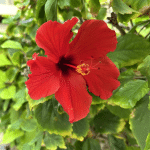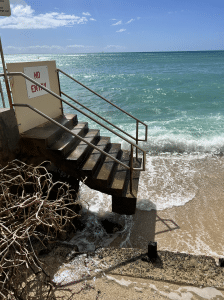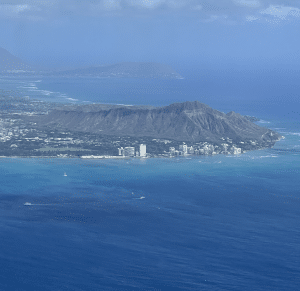
Unveiling God’s Creation: A Scientific Look at Hawaii’s Wonders
To the choirmaster. A Psalm of David. The heavens declare the glory of God, and the sky above proclaims his handiwork. –Psalm 19:1
Aloha! My family and I recently visited Waikiki Beach in Honolulu, on the island of Oʻahu. With the breathtaking ocean and mountains, this peaceful place revealed the beauty of God’s glorious creation everywhere I looked.
Let’s take a journey to this little slice of paradise and explore this piece of God’s creation together.
Fun Fact: Hibiscus Flowers

A Delicate Ecosystem
On the plane, the flight attendants distributed a disclosure form to all passengers. Hawaii has a very delicate ecosystem, so each person was required to list any animals, plants, or other vegetation in their possession. The islands have no snakes or major wild predators, and all the plants are either native or controlled by environmentalists. If a foreign plant were brought in, its seeds could spread, growing more of that plant. Plants that are not native to an area can use up the resources, causing the native plants to die out, and potentially causing an ecological disaster.
This also applies to animals. If a foreign animal were brought in and it had no known predators to keep the population in check, it could wreak havoc. An animal without nearby predators would mean that the animal could roam free, eating whatever it wants, causing a major imbalance to the ecosystem.
Foreign plants and animals could also bring in foreign diseases to the locals. Sometimes plants and animals carry a disease, or have vessels, like mites, that carry one. As we’ve seen with other diseases, without the specific antibodies for that disease, it can cause a lot of damage.
Island Living
The only real predator that people fear in O’ahu is the wild boar. While small in stature, these animals are fearsome because they dig up the ground to eat tree roots. Digging the soil and eating the tree roots loosens the ground, which can cause landslides that damage homes and cause injury to people.
At Kualoa Ranch, we learned that to combat the wild boar problem, people have set up traps to catch them. Then they bring the boars to a pen where they feed and take care of them until they’re ready to join the luau—as the main dish! While some people may not agree with this practice, it is important to the local people.
Because Hawaii is an island, most of the things that people need (groceries, gas, clothing) must be imported from the U.S. mainland. Because of this, the cost of living in Hawaii is very high. For instance, a gallon of milk can cost anywhere between $6 and $10, a gallon of gas is a little under $5, and home prices begin at around $1.2 million. In response to these prices, people are using their own resources more in an attempt to live more off the land, which includes eating wild boar. Places like Kualoa Ranch grow a variety of fruits and vegetables and raise animals like cows, sheep, pigs, and chickens to produce meat, milk, and eggs at a lower cost on the island.
Island Living Activity
The next time you and your family go to a store or market, take a look at the prices. How much do you pay for a gallon of milk or other items in your town, compared to the amount someone living in Hawaii would pay for these same items?
You will need:
- Trip to the grocery store or market
- Trip to a gas station
- Pencil or pen
- Piece of paper
- Internet access (with a parent’s help or permission)
You will do:
- The next time you go to the grocery store or market, take your pencil and paper. Mark the paper as “Home Cost” and “Hawaii Cost” with a line down the middle.
- In the “Home Cost” section, write down the prices of groceries, such as eggs and milk, or other items, such as shoes or anything else you buy.
- If you stop to put gas in the car, write down the price per gallon and the total cost of your fill-up. If you don’t need to stop for gas, mark down the price at a local gas station and ask your parent how many gallons it takes to fill up your car. When you get home, calculate how much money it would have cost to fill up the whole tank. At the end of your “Home Cost” list, mark down the total cost of your trip to the store, including what you purchased and the cost of a gas fill-up.
- Look up how much the goods you purchased would cost in Hawaii, including the gas. Be sure to ask permission before going on the internet and always use safe internet practices. Add up the total cost of your purchases in Hawaiian prices and mark it down in the “Hawaii Cost” section.
- Subtract the “Home Cost” from the “Hawaii Cost.” This is how much more money you would have to spend to purchase the same items in Hawaii compared to how much they cost where you live.
Don’t Feed the Birds
O’ahu’s restaurants and shops are primarily located outdoors. So, we saw many signs that read, “Don’t Feed the Birds” or “Don’t Feed the Wildlife.”
There are several reasons for this:
- Feeding wild animals food separate from their natural diet can make them very sick.
- Feeding wild animals encourages them to return because it is an easy source of food. They, of course, tell their friends, and so more and more animals begin to linger around the establishment. Now, not only are there lots of animals that may try to steal your food, but they can also carry diseases.
- Feeding wild animals makes them less fearful of humans, also known as habituation. When animals become habituated to people, they start to rely on them for food. This can cause them to lose their natural survival skills. In some of the worst cases, they must be placed in rescue centers. If a larger, more dangerous animal becomes habituated to humans, it could even pose a threat to human safety.
An Island Washing Away
Our hotel was listed as a beachfront hotel online. The photos had shown large beaches that stretched from the building to the shoreline, but when we got there, the beachfront hotel looked more like a waterfront hotel. The beach had all but washed away.
Why are the beaches eroding? This is a slow, but natural process. When the waves crash along the shoreline, the receding water (the waves going back into the ocean) takes a little bit of the sand along with it. Over the course of many years, this causes the shoreline to shorten. Other possible contributing factors include hurricanes, which can cause the sand to disappear more quickly, and rising sea levels.
It’s possible that this beach erosion could deter tourists, one of Hawaii’s main sources of income. The simple solution seems to be importing sand, but the main concern with that is the sea creatures that have now called the expanded ocean their home.
“Turtley” Awesome
Every day, when I went out onto the balcony, I saw sea turtles swimming fairly close to the edge of the hotel. One would pop up and then dive down, probably to get its meal before popping back up for air. There was likely a kelp or seagrass bed below the waterline that the turtles were feeding from.
Boats frequently traveled back and forth from the shore to a specific spot in the water. They were bringing passengers to look at a group of sleeping turtles!
This is a known spot in the channel, between the deep ocean and the shore, where the turtles like to rest. It’s a great spot because the turtles do not have to worry about sharks swimming overhead. However, expanding the beaches could not only cause the sea turtles’ new home to be threatened, but also hurt countless other animals that have now “moved in” to the new area.
The locals take sea turtle safety very seriously. Harassing the turtles; things like touching, poking, petting, feeding, or bothering their nests are prohibited.
Touching or moving the eggs in a nest could harm the hatchlings, and we wouldn’t want to harm any of God’s creatures. Typically, wildlife rescues or sanctuaries know where a majority of sea turtles lay their eggs and rope off the nests to keep them safe.
Learn more about how rescue organizations track sea turtle nesting seasons here.
Clearwater Marine Aquarium 2024 Sea Turtle Nest Season Results
Lē’ahi
Our hotel room had a stunning and picturesque view of Waikiki Beach. We could see a volcanic crater called Diamond Head, also known as Lēʻahi.
When sailors first explored the island, they thought they had found diamonds at the base of the mountain. After this rich discovery, they quit their jobs to mine for the gems. Little did they know that what they had found was not diamonds but merely worthless calcite crystals.
Fun Fact: 50th State
Hawaii became our 50th state in August 1959. Oʻahu is one of the eight main islands that make up the state, along with Hawaiʻi, Maui, Kahoʻolawe, Lānaʻi, Molokaʻi, Kauaʻi, and Niʻihau.
Aloha and Mahalo
Check out Exploring Creation with Earth Science, Exploring Creation with Zoology 1, 2, or 3, Exploring Creation with Physical Science, or Exploring Creation with Marine Biology to learn more about related content.
Until next time, aloha and mahalo (thank you) for reading. Keep exploring God’s wonderful creation!
Photos by Tabitha Ludwiczak







